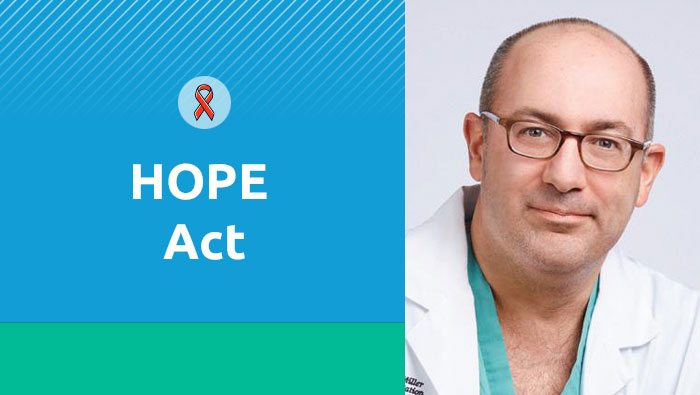On Nov. 21, 2015, the Organ Procurement and Transplantation Network implemented the process to perform transplants through the HIV Organ Policy Equity (HOPE) Act. For the first time, this allowed organs from donors diagnosed as HIV-positive to be transplanted into recipients who are also HIV-positive.
More than 220 HOPE Act transplants have now taken place nationwide. Mount Sinai Hospital in New York City has performed the most transplants of any hospital—67 as of September 2020. Sander Florman, M.D., director of the Recanati/Miller Transplantation Institute at Mount Sinai, recently offered some perspectives on the meaning of the program and its fifth anniversary.
What does the HOPE Act mean for candidates and for potential donors with HIV?
We’re serving our community. There is a large group of HIV-positive patients in our area. There are therapies available to treat HIV effectively, but people who are HIV-positive are going to have other medical conditions to treat such as heart attacks, strokes, and kidney and liver failure. For the carefully selected patients who have not had a lot of opportunistic infections, who have well-controlled HIV with no viral load, we should offer transplant options to them because they are going to do well, and they deserve the opportunity.
One of the staggering things about the HOPE Act, which I didn’t really understand until it came into effect, is it’s very, very meaningful to people who have HIV to know that they can now be donors themselves—to know they can help others even after their own death.
How has the protocol changed treatment for HIV-positive people?
It’s night and day. Even without the HOPE Act, we were still transplanting people with HIV, just not with HIV-positive organs.
The first transplant done at Mount Sinai for an HIV-positive patient was done by Dr. Charlie Miller in 1998. It was a living donor liver transplant. The recipient is still alive and did well. We started really in earnest doing kidney and liver transplants here around 2000, right when the first UCSF/NIH HIV protocol came in. I went to Tulane for a while and did the first HIV liver transplant there. That recipient is still alive. So these people are going to do well. We all want to serve our patients.
If you agree to take a HOPE Act organ, you’re probably going to get one much quicker than the average wait. If you are willing to take a HOPE Act kidney, the wait is probably a year or two. For liver there are only six, 10 people at any time in the country. You can get offers very quickly with a relatively low MELD.
What is different in patient treatment? Organ utilization?
These are more complicated cases. You do need a different team approach, especially when you’re transplanting organs from donors who had HIV. You have to take into consideration their HIV resistance patterns and their virus, in addition to the recipient’s. It’s a colossal team effort with very sophisticated infectious disease doctors who specialize in this, and with medical and surgical counterparts in transplant who want to take care of these patients.
I’ve always had the policy with the surgeons and the staff here that they can confidentially opt out of participating in these cases. I used to have people opt out. Today nobody opts out. Everybody understands, and the sentiments around HIV are much different.
There’s no question that the risk of organ rejection is higher—three-to four-fold higher. We now anticipate more for that. We tend to give a little more immunosuppression, which seemed counterintuitive for somebody with HIV. If you give somebody with immunodeficiency more immunosuppression, aren’t you going to create AIDS? The answer is that HIV really isn’t immunodeficiency—it’s immune dis-regulation, not just that it’s low. We learned anecdotally, here and at places like Pittsburgh and UCSF, that some of our immunosuppressive drugs actually work to inhibit viral entry into the cell. They often work synergistically with the HAART medicines.
Another complication is that recipients are on so many more medications that have so many interactions with our medications. Also, a lot of our initial experience was that these patients never thought they’d have a transplant, had lots of comorbidities, and waited for transplant a lot longer than other patients. That takes a toll. Having said that, our results stack up to at least as good as the higher-risk older recipients, and maybe even our more standard recipients today.
An unintended effect is in false positive HIV results. Tests done at hospitals are meant to not miss any HIV cases, and they can have a high rate of false positivity. So previously that meant none of those organs could be used. Many HOPE Act patients have gotten organs that were subsequently shown not to be HIV-positive—organs that before would have been buried and not used. Also, every time someone with HIV is transplanted with these organs, someone else moves up the waiting list a little.
What challenges remain?
We expected, based on data, that there would be far more HIV donors available. We’re learning that OPOs that feel comfortable recovering these donors do this; others haven’t been as comfortable. It takes a lot of effort, particularly in smaller hospitals where HIV still has a big stigma. Just like transplant centers have to feel comfortable doing this, and more and more are, the OPOs need to feel more comfortable.
How do you view the five-year anniversary?
Open any medical textbook from even about ten years ago—HIV is an absolute contraindication to transplant. We’ve changed that.
There are tremendous kudos to everybody for making this happen. The Department of Health and Human Services, UNOS, the dedicated teams at places like UCSF and Johns Hopkins who have overseen the NIH multicenter trials have done very good work. For a lot of people, this is on the cutting edge, and we’re proud to be a part of it.

